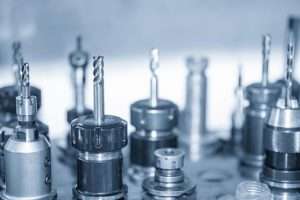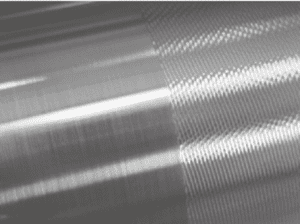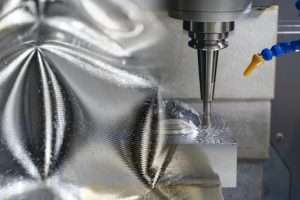
Wear on the drill bit.
CNC machining is a widely used manufacturing process that involves automated CNC machines to create precise and complex parts. Despite its precision, CNC machining is often prone to several defects, and one of the main causes is tool wear.
The impact of tool wear on CNC machining defects is a significant issue in manufacturing, as it affects production efficiency, accuracy, and profitability. This article will examine the defects caused by tool wear in-depth, including how it causes, how to identify the wear, and many more.
What is meant by Machining Defects?
Machining defects refer to any deviations from the intended design during the CNC machining process. It means machining defects are imperfections in the machining process that are unwanted and affect the various aspects of machining parts or products. Tool wear increases cutting force, vibration, and temperature in end milling and reduces the surface finish of the machined workpiece (S, 2010).
Following are some common defects that might occur during CNC machining.
- Tool marks on the surface

Tool marks on the surface
Tool marks are the most common machining defect that occurs when the cutting tool leaves marks on the surface of the machined part. It can be caused by improper tool selection, worn or damaged cutting tools, or incorrect cutting parameters.
- Cracks or material distortions
Cracks can occur due to excessive cutting forces, improper tool selection, or workpiece material defects. It can result from unsuitable cutting conditions, workpiece material variations, or heat buildup during the machining process.
- High roughness
Surface roughness is another possible machining defect and refers to the irregularity or unevenness of the surface texture of a machined part. It occurs due to improper cutting conditions, tool wear, or deflection.
What is meant by Tool Wear?
Tools are essential in any CNC machining operation to cut and shape the material. Common types of tools used in CNC machining include end mills, drills, and lathe tools. These are typically mounted on a spindle, which rotates at high speeds and is guided along a programmed path to produce a desired shape or form.
Tool wear in CNC machining is the gradual degradation of material from the tool’s cutting edge during the machining process. It is a common phenomenon due to several factors, such as repeated contact with the workpiece, friction, and heat generated by the cutting process.
As the cutting edge becomes dull or damaged, the quality of the machined parts decreases and the tool must be replaced or resharpened. In some cases, excessive tool wear can cause premature tool failure, leading to longer production times, increased production costs, and the need for frequent tool changes.
Therefore, it is important to monitor and control tool wear in CNC machining to minimize or eliminate possible machining defects.
How Does Tool Wear Create Machining defects in CNC?
Tool wear lowers cutting-edge sharpness, alters tool geometry, and demands more cutting force to perform any CNC machining operation.
- Tool wear lowers the cutting-edge sharpness
Tool wear lowers the cutting edge’s sharpness. As the tool’s cutting edge becomes dull or damaged, its ability to effectively remove material from the workpiece is decreased. As a result, it reduces the surface finish quality, which is noticeable as roughness, scratches, or other imperfections on the surface of machined parts.
Additionally, as the cutting edge becomes duller, it creates more heat, causing additional damage to the tool and the workpiece, leading to an increased risk of tool breakage and other machining defects.
As the tool wear increases continuously with time, it becomes so dull that the tool can no longer remove material effectively. Furthermore, a flat cutting edge can cause the tool to rub against the workpiece instead of cutting it, leading to increased friction, heat, and wear on both the tool and the workpiece. This can further degrade the quality of the machined parts and increase the risk of tool breakage.
- Tool wear increases the cutting forces
When the cutting edge of the CNC tool becomes dull or damaged, the forces required to remove material from the workpiece increase. For example, the high cutting speeds while turning will result in quicker tool wear compared to higher feeds (Bhushan, 2022).
Now, let’s discuss some CNC machining defects that can be caused by an increase in the cutting forces.
| Tool chatter | It is a vibrational phenomenon that increases cutting forces because that amplifies the significant vibration and leads to surface roughness, uneven texture, dimensional instability, and risk of tool breakage or failure. |
| Tool breakage or failure | When cutting force increases in CNC machining, it can cause excessive stress on the tool, leading to tool breakage. This can further cause significant production downtime, increased production costs, and the necessity for frequent tool changes. |
| Workpiece deformation | High cutting forces can also result in the deformation of the workpiece, which influences the dimensional accuracies and the quality of the intended parts. |
- Tool wear impacts the tool geometry
As the machining tools wear with time, they can change the initial shape and geometry, leading to deviations from the desired shape or form of the machined parts. This can result in many machining defects;
- Alteration tool geometry can lead to deviations from the specified dimensions of the machined parts, resulting in dimensional errors and lower quality.
- Changes in tool geometry can also impact the surface finish quality of machined items, leading to roughness, scratches, or other flaws.
- Tool wear lowers the cutting performance.
Reduced cutting performance is a result of tool wear in CNC machining. As the tool ages and wears, it loses its optimum capacity to remove the material from the workpiece. As a result, it causes increased tool wear, high cycle time, poor production quality, and decreased cutting speed.
The common effects of low cutting performance of tools in CNC machining include;
- Cutting speed can be decreased due to poor cutting performance, increasing production times, and reducing production efficiency.
- Each item takes longer to make, resulting in longer cycles and less productive manufacturing.
- Reduced cutting performance can lead to more tool wear, frequent tool replacements, and shorter tool life.
- Cutting performance issues can lead to reduced product quality, more production faults, and less efficient production.
How to Minimize the Tool Wear in CNC Machining?
As previously discussed, we know tool wear is the primary cause of many CNC machining defects. So, preventing or minimizing wear is important for a quality result.
The following are some ways to minimize tool wear in CNC machining;
Choose the right tool: Choosing the right tool according to job specifications is critical in reducing tool wear. The type of tool, its geometry, and the material all directly influence the lifespan and wear resistance. Therefore, consider the material type of workpiece, the desired cutting parameters, and the surface finish.
Optimize the cutting parameters: Inappropriate cutting parameters such as cutting speed, spindle RPM, and cutting depth also cause the tools to wear, leading to several machining defects. As a result, the cutting parameters should be fixed optimally based on a particular machining project.
Apply the coating: Coating titanium nitride, Chromium Nitride, or other hard substances improve the tool’s durability and minimizes wear. These coatings can reduce friction, increase hardness, and improve wear resistance.
Use suitable coolants: Heat buildup is one of the prime causes of tool wear. Proper use of coolant and regular maintenance of the coolant system can help reduce friction and heat buildup, reducing wear on the tool. Coolant can also help remove chips and debris from the cutting area.
Tool maintenance: The regular maintenance of tools, such as cleaning and sharpening, contributes to a longer life and minimizes tool wear. Also, it is crucial to handle and store the tools properly.
How to Identify the Tool Wear in CNC Machining?

Uneven surface texture
It is only possible to counter any CNC machining problems if you notice them. Similarly, it is essential to identify the tool wear to eliminate the risk of possible machining defects.
Here are some ways to identify tool wear in CNC machining;
- Visual inspection is one of the best techniques to ensure tool wear. You can inspect for the signs of wear, such as dull cutting edges, chips, or cracks.
- Analyzing the surface finish quality of machined parts also reveals signs of wear, such as tool marks, unexpected roughness levels, and uneven texture.
- Vibration is another way to identify tool wear. There is a possibility of tool wear if there is vibration in any parts of the CNC machine, cutting tool, and the tool itself.
Summing Up
The quality of machined products and the extent of machining flaws are both significantly impacted by tool wear. The reasons for wear include but are not restricted to the age of the tool, cutting conditions, tool selection, and cutting parameters.
A proactive approach to managing tool wear, like selecting the right cutting tools, using proper cutting parameters, and monitoring cutting forces, is the best way to avoid possible machining defects.
At Prolean, we give top priority to the monitoring of tool wear and possible defects. Our experienced engineers and operators closely collaborate with the quality control team to eliminate the risk of any possible machining defects in the CNC machining project.
FAQ’s
What are the common machining defects?
Tool wear can impact the surface finish quality, dimensional consistency, and overall quality of parts. It is the prime cause of roughness, cracks, tool marks, dimensional errors, and tool breakage.
How does tool wear impact the CNC machining defects?
Tool wear reduces the sharpness of the cutting edge, increases cutting forces, and changes tool geometry. As a result, increased friction, heat, and the risk of tool breakage.
What are the ultimate consequences of excessive tool wear in CNC machining?
Excessive tool wear in CNC machining can cause premature failure, longer production times, high production costs, and frequent tool changes.
References
- S, S. P. (2010). Prediction of tool wear from machining parameters by response surface methodology in end milling. International Journal of Engineering Science and Technology.
- (2022). Effect of tool wear on surface roughness in machining of AA7075/ 10 wt. % SiC composite. Composites Part C: Open Access, 8, 100254. https://doi.org/10.1016/j.jcomc.2022.100254




0 Comments